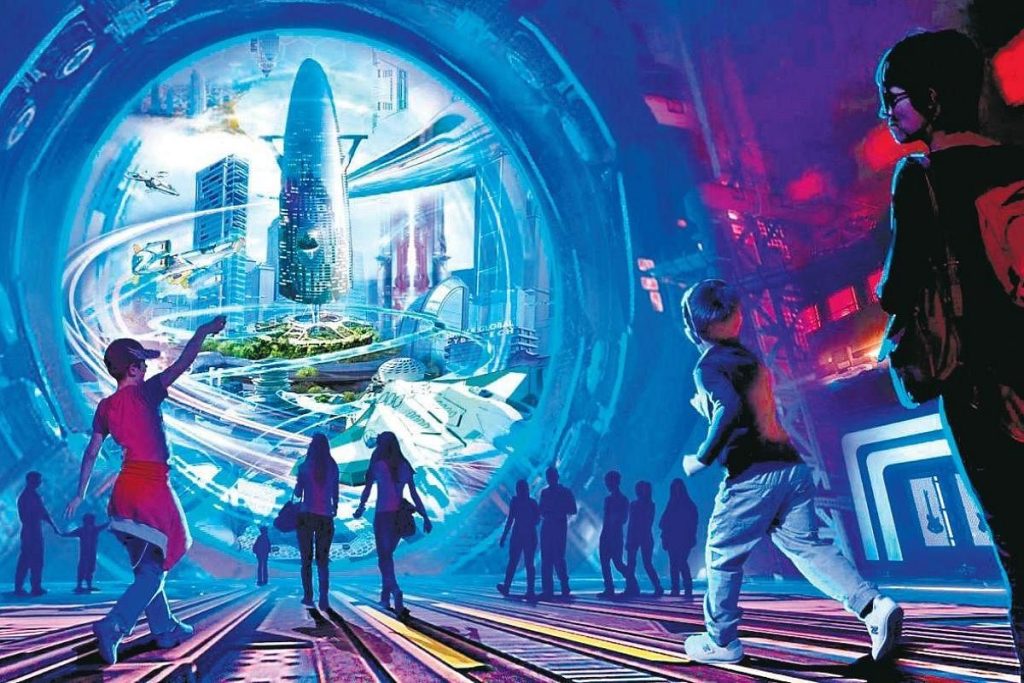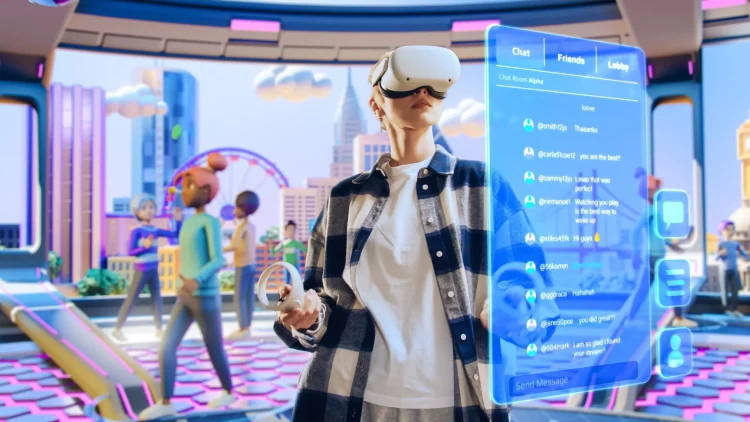Introduction
In the past few decades, the world has witnessed rapid technological change. The rise of the internet reshaped how humans communicate, the advent of smartphones made connectivity ubiquitous, and social media platforms redefined how communities form and interact. Yet, all of these innovations may represent only the beginning of a larger transformation. The concept of the metaverse—a collective, immersive digital universe where the physical and virtual worlds converge—is poised to redefine digital interaction and human experience on a scale previously unimaginable.
The metaverse is not simply an extension of online gaming, nor is it just a virtual reality playground. Instead, it is envisioned as an interconnected ecosystem of digital environments that allow people to work, socialize, trade, learn, and explore in ways that blend seamlessly with the physical world. Just as the internet became a central infrastructure of modern life, the metaverse promises to be the next great platform for human interaction.
This article explores the rise of the metaverse, its technological foundations, social and economic implications, ethical challenges, and its transformative potential for redefining human experience in the digital age.
The Origins and Evolution of the Metaverse
The term “metaverse” first appeared in Neal Stephenson’s 1992 science fiction novel Snow Crash, which described a virtual world where people interacted through digital avatars. While fictional at the time, Stephenson’s vision inspired a generation of technologists and entrepreneurs. Early precursors of the metaverse can be seen in online multiplayer games like World of Warcraft, Second Life, and more recently, Roblox and Fortnite. These platforms demonstrated the human desire to inhabit shared digital spaces, form communities, and even create functioning economies.
The evolution of the metaverse has been driven by three intersecting technological trends:
- Immersive Hardware: Virtual reality (VR) headsets, augmented reality (AR) glasses, and haptic devices enable more natural and embodied experiences in digital environments.
- Persistent Virtual Worlds: Advances in cloud computing, artificial intelligence, and blockchain technology allow digital worlds to exist continuously, with user-created content and economies that persist even when individuals log out.
- Interoperability and Networking: As digital ecosystems grow, the push for interoperability—the ability for assets, identities, and experiences to move across platforms—becomes essential for creating a true metaverse rather than isolated silos.
While the vision is still in development, the metaverse has already become a focal point for tech giants like Meta (formerly Facebook), Microsoft, and Tencent, as well as for startups building specialized platforms and applications.
Redefining Digital Interaction
The defining feature of the metaverse is its ability to transform digital interaction into something more immersive, embodied, and communal. Unlike traditional digital platforms that rely on text, images, or video, the metaverse offers presence—the feeling of “being there” in a shared space with others.
1. Social Connectivity
Social media platforms revolutionized communication, but they often reduced interaction to likes, comments, and curated feeds. The metaverse reintroduces depth to digital socialization by allowing users to interact as avatars in three-dimensional spaces. A conversation in a virtual café, for example, can mimic the nuances of face-to-face interaction, including gestures, spatial awareness, and body language.
2. Collaboration and Work
The COVID-19 pandemic accelerated the adoption of remote work, revealing both its benefits and limitations. Video conferencing tools enabled connectivity, but many people reported “Zoom fatigue” due to the lack of physical presence. The metaverse promises to address this by offering immersive virtual offices where colleagues can collaborate on 3D models, brainstorm in virtual whiteboard rooms, or attend conferences with thousands of participants represented by avatars. Microsoft’s “Mesh for Teams” and Meta’s “Horizon Workrooms” are early examples of this trend.
3. Entertainment and Leisure
Gaming has already become a central driver of metaverse experiences. However, the metaverse expands entertainment beyond gaming, encompassing live concerts, virtual tourism, and immersive storytelling. Platforms like Fortnite have hosted live performances by artists like Travis Scott, attended virtually by millions of fans simultaneously—an experience impossible to replicate in physical venues.

The Economic Dimension of the Metaverse
The rise of the metaverse is not only a cultural phenomenon but also an economic revolution. By blending digital and physical economies, it opens unprecedented opportunities for businesses, creators, and consumers.
1. Virtual Economies
Metaverse platforms host fully functioning economies where users can buy, sell, and trade digital goods. These range from avatar clothing and accessories to virtual land and architecture. Blockchain technology and non-fungible tokens (NFTs) enable ownership, scarcity, and transferability of digital assets, fueling a new wave of economic activity. For example, companies like Decentraland and The Sandbox allow users to purchase virtual real estate, which can then be developed, rented, or sold much like physical property.
2. New Business Models
Just as the internet enabled e-commerce, the metaverse is creating opportunities for immersive commerce. Brands like Nike, Gucci, and Balenciaga have already experimented with selling digital fashion items for avatars, sometimes commanding prices rivaling their physical counterparts. Businesses may also operate virtual storefronts, host product launches in digital spaces, and even offer metaverse-native services.
3. Employment and Entrepreneurship
The metaverse is giving rise to new forms of work and entrepreneurship. “Metaverse architects,” “virtual event planners,” and “digital asset designers” are emerging roles. Content creators are finding audiences and customers in virtual worlds, while freelancers can offer services ranging from avatar customization to virtual real estate development.
The Human Experience in the Metaverse
While the metaverse is primarily understood through its technological and economic dimensions, its most profound impact lies in how it reshapes the human experience.
1. Identity and Self-Expression
Avatars allow individuals to express themselves in ways that may not be possible in the physical world. For some, this may mean enhancing their physical likeness, while for others, it could mean experimenting with entirely new identities. This flexibility raises questions about authenticity, identity fluidity, and the psychological effects of inhabiting alternate selves.
2. Education and Learning
The metaverse has vast potential for education by making learning more interactive and experiential. Students could explore historical events through immersive reenactments, conduct complex science experiments in virtual labs, or collaborate globally in shared digital classrooms. This approach has the potential to democratize education, providing access to high-quality resources regardless of geographical or economic barriers.
3. Healthcare and Therapy
Virtual environments can support mental health therapy, rehabilitation, and even physical treatments. VR-based exposure therapy has already been used to treat PTSD, while virtual reality fitness programs encourage healthier lifestyles. The metaverse could extend these possibilities by providing accessible, scalable, and customizable healthcare experiences.
Ethical, Social, and Cultural Challenges
The rise of the metaverse also raises critical ethical, social, and cultural challenges.
1. Privacy and Data Security
The metaverse will collect vast amounts of data, not just about what users say and do but also about their gestures, movements, and even biometric signals. This raises concerns about surveillance, data misuse, and the commodification of personal behavior.
2. Inequality and Accessibility
If the metaverse becomes central to work, education, and social life, access to hardware and connectivity will determine participation. Without careful planning, this could exacerbate the digital divide, leaving behind those without resources to join the metaverse.
3. Mental Health and Addiction
Immersive environments are designed to capture attention, raising the risk of addiction or detachment from physical reality. Prolonged engagement may affect mental well-being, relationships, and perceptions of self.
4. Governance and Regulation
Who will govern the metaverse? Will it be dominated by a handful of tech companies, or will it evolve into a decentralized ecosystem? Regulation is necessary to address fraud, intellectual property disputes, and harmful behavior, but overregulation could stifle innovation.
The Future of the Metaverse
The metaverse remains a work in progress, but its trajectory suggests it will become increasingly integral to human life. In the near term, its adoption will likely be concentrated in entertainment, gaming, and professional collaboration. Over time, however, it could expand into nearly every sector of society, including education, healthcare, retail, and governance.
The long-term vision is of a seamlessly integrated physical and digital existence, where boundaries between offline and online are blurred. As hardware improves, as interoperability increases, and as cultural norms shift, the metaverse may become as essential as the internet itself.
Conclusion
The rise of the metaverse marks a turning point in human history, comparable to the advent of the internet or the industrial revolution. By redefining digital interaction, it offers opportunities for richer, more immersive connections and experiences. At the same time, it raises profound ethical, social, and cultural questions that demand thoughtful navigation.
The metaverse is not merely a technological innovation—it is a new stage in the evolution of human experience. Whether it becomes a utopia of creativity, collaboration, and empowerment or a dystopia of surveillance, inequality, and addiction depends on the choices made today by developers, policymakers, and society at large.
As we stand on the cusp of this transformation, one thing is clear: the metaverse is not just about virtual worlds. It is about redefining what it means to be human in the digital age.
















































